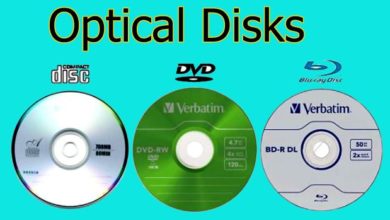Communication Channels and Their Types
Table of Contents
In a network, a communication channel or media is a connection between transmitter and receiver through which transmission signals travel. A communication channel ensures computer connections and the transmission of information in a network. Types of communication channels are Guided Media, Unguided Media.
What is Communication Channel?
A communication channel also known as communication media or transmission media is a path that connects the sender and receiver for the transmission of information over a network. Common examples of transmission media are Twisted pair, Coaxial cable, Fiber optics & Satellite, etc.
Importance Of Communication Channels
The physical layer is the bottom layer in the open systems communication reference model (OSI). This layer makes sure of the transmission of bits through the telecommunication channels. Design issues which occur in this layer are physical, electrical, timing, physical transmission media.
Types Of communication Channels
A communication channel or transmission media is a path that connects the sender and receiver for the transmission of information over a network. A communication channel ensures computer connections and the transmission of information in a network. Types of communication channels are Guided Media, Unguided Media.
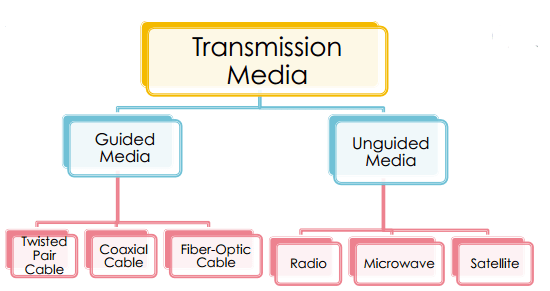
Explore More:
- Data Transmission Modes in Computer Network
- Data Communication & Its Components
- Types Of Network Devices & Communication Technologies
- 4 Types of Communication Devices
Guided or Physical Transmission Media
In guided transmission media, communication devices are directly connected with each other via wires or physical media for data transmission. Guided media is also known as bounded media because the data signals are enclosed to a cabling media. The guided media is mostly used in LAN.
Some examples of bounded media for communication are as follows:
- Twisted Pair Wire
- Coaxial Cable
- Fiber Optics
Twisted Pair Wire
Twisted pair wire is the most commonly used communication media in LAN (Local Area Network) for data communication among the computers. Normally, the twisted pair wires are used in local telephone lines to carry voice and data signals

This cable is almost made up of copper coated with an insulating material like plastic. The pair of wires are twisted together in order to reduce noise. The electrical disturbance that can degrade the communications is called noise.
In addition, the data transmission speed of the twisted pair wire is near about 9600 bits per second at a distance of 100 meters. The twisted pair is inexpensive and has less speed than coaxial cable or fiber optics.
Advantages
- Easy to install
- flexible
- Inexpensive
- Its speed capacity is high
- 100-meter limit
- Higher degrees UTP is used in LAN technologies such as Ethernet
Disadvantages
- Bandwidth is less than coaxial cables
- It has less resistance to interference
Coaxial Cable
Coaxial cable is also termed coax. It carries high-frequency range signals than twisted-pair cable. It is made up of a single solid copper wire core that is covered by insulating material. A copper mesh is used to cover the insulated copper wire. It also protects the cable from electromagnetic waves.

Coaxial cable is the same cable that is used for television. This cable is used for long-distance telephone lines and local area networks for voice and data transmission with very high frequency. Coaxial cable bandwidth is 80 times higher than the twisted-pair wire. So, it is more expensive than twisted pair.
There are two types of coaxial cable: A 5mm thick coaxial cable and a 10mm thick coaxial cable. Thick coaxial cable is less than twice as thick as thin cable. The cost of coaxial cable is higher than that of twisted-pair cable.
Network installation is more complicated than that of twisted-pair cable. . Coaxial cable is more resistant to noise and reduces radiation than twisted pair cable. Bandwidth – 50-100 Mbps.
Advantages
- High bandwidth
- Use in long-distance telephone lines
- 10Mbps high-speed digital signal transmission
- Transfer data safely
- Compared to twisted pair cables, they can have higher speeds and better protection over long distances.
Disadvantages
- Failure of one cable will disrupt the entire network
- Difficult and expensive installation
- If the protector is defective, it is possible to create a ring
Performance
Although these types of cables have more bandwidth and speed compared to twisted pair cables, the voltage drop and signal attenuation is more and requires repeated use of a repeater.
Application
- Analog TV networks
- Cable TV networks
- In Ethernet networks
Fiber Optics
Fiber optics is also known as light pulse media. It uses a binary method of data transfer. Fiber is made up of thin glass fiber. A fiber optics consists of a very narrow fiber of glass called the core. It is thinner than human hair. There is no possibility of data loss.
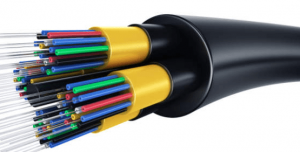
In addition, the best advantage of fiber optics is that data is already in binary form and it just needs to be converted into light only. It can transmit data up to billions of bits per second. The main disadvantage of fiber optics is that it is very expensive and also difficult to install and modify.
The twisted pair is completely soundproofed. There are two cables for this cable: the wireless UTP twisted pair cable and the STP twisted pair shielded cable. This cable is easy to install.
This cable is the cheapest and most popular form of connection widely used in the most common LANs with Ethernet architecture. This cable connects to network devices via an RJ45 connector. This cable is used to transmit data at speeds of 10 Mbps and 100 Mbps.
Fiber Optics cable is used for
- Internet services
- Long-distance communication
- Local area network
Advantages
- High bandwidth
- Less attenuation of signals
- Protect against electromagnetic interference
- Corrosion-resistant
- lightweight
- High safety
Disadvantages
- Hard installation and maintenance
- One-way light emission
- High cost
Performance
Voltage drop as well as the need for repeaters is less compared to coaxial cable and twisted pair cable.
Applications
It is often used in the body of networks because its bandwidth is affordable. Some cable TV networks use a combination of fiber optics and coaxial cable. It is also used in the Local Area Network.
Unguided or Wireless Transmission Media
The communication devices in unbounded communication channels /media communicate with each other through air or space using broadcast radio signals, microwave signals, and infrared signals as a medium. Unbounded media can also be used at each and every place where it is impossible to install cables. The best solution is to use unbounded media.
Data can be transferred to each and every place in the world by using unbounded media. Some examples of unbounded communication channels are as follows:
- Microwave System
- Communication Satellite
- Broadcast Radio
- Cellular Radio
- Infrared
Terrestrial Stations Or Microwave Stations
Microwaves are radio waves that are used to provide high-speed transmission. The user can also transmit both voice and data through microwaves. From one Terrestrial Station to another data is transmitted through the air similar to radio signals. The microwave uses line-of-sight transmission.
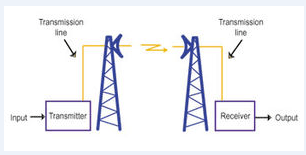
Line-of-sight transmission means that the signals travel in a straight way and cannot bend. The microwave uses line-of-sight transmission. Sight transmission means that the signals travel in a straight way and cannot bend. The microwave stations or antennas are usually installed on tall towers or buildings.
Terrestrial stations are placed within 20-30 miles to each other. Each station receives the signals being transferred by the previous station and then transfers these signals to the next station. This is the way how data is transferred from one place to another.
However, It is almost necessary to keep in mind that there should be no buildings or mountains between microwave stations.
Applications
Microwaves are very useful because they are one-way when there is a need for one-to-one communication between transmitter and receiver.
These waves are used in mobile phones, satellite networks, and wireless networks.
There are two types of microwave transmission:
- Land transfer
- Satellite transmission
Advantages
- It is very suitable for long-distance telephony (in general communication)
- It can carry 100 audio channels
Disadvantages
- it is very expensive
Communication Satellite
A Communication Satellite is a space station. It receives microwave signals from the earth station. Communication satellites magnify the signals and retransmit them back to earth. The communication satellite is established in space that is very far near about 22,300 miles above the earth.
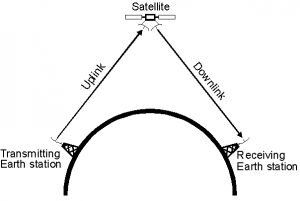
In addition, The data transfer speed of the communication satellite is very high. The transmission from the earth station to a satellite is called an uplink. The transmission from the satellite to the earth station is called the downlink.
Benefits of satellite transmission
- Transmitter stations can receive their signals. By doing this, they can ensure the accuracy of the information
- Being a microwave relay station that is accessible from anywhere
Disadvantages
- The cost of building, installing, and setting up satellites is very expensive
- The transmission of information strongly depends on the weather conditions and is influential
Broadcast Radio Waves
The Broadcast radio is a wireless transmission medium. It distributes radio signals through the air over long and short distances. Radio transmission requires a transmitter to send broadcast radio signals and a receiver to receive them. The receiver uses an antenna to receive the signals.
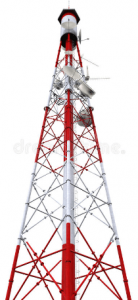
Some networks use a transceiver that can both send and receive signals. An example of short-range broadcast radio communications is Bluetooth. It uses short-range radio waves to transmit data at a rate of 1 Mbps among Bluetooth-enabled devices.
In addition, Bluetooth is used in personal computers, internet appliances, cellular phones, fax machines, and printers also.
Applications of Radio Waves
The omnidirectional feature of sending radio waves is useful for media that have one transmitter and many receivers
Cellular Radio
Cellular Radio is a broadcast radio that is used for mobile communications. It is specifically used in wireless modems and cellular telephones. The cellular telephone is also a telephone device that uses high-frequency radio waves to transmit voice and digital data.
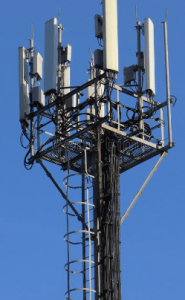
However, some mobile users connect notebooks or mobile computers to the cellular telephone to access the Web or send and receive an email, etc. Personal Communications Services (PCS) is a set of technologies used for digital cellular devices like Handheld computers, cellular telephones, etc.
Infrared
Infrared (IR) is a wireless transmission media. It sends signals using infrared light waves. it requires a light–of–sight transmission.
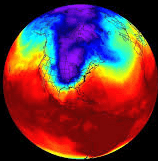
IrDA port is normally fixed in mouse, printer, and digital camera in order to enable them to transfer data from one device to another using infrared light waves. It is also an alternative to short-range radio communication like Bluetooth.
Applications
- The infrared band is approximately 400THz, which has a high potential for data transmission.
Such broadband can be used to transmit digital data at high transmission rates. - These waves can be used in communication between devices such as a mouse, keyboard, and printer.


